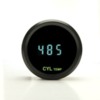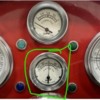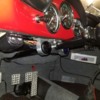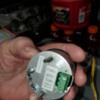Hi guys, anyone know where to get a head temperature gauge setup for my 356 CMC? The mechanic recommended it but does not have a supplier.
Replies sorted oldest to newest
I have a Dakota Digital CHT gauge and thermocouple sender and wire for sale. It has chrome bezel ring and blue light digital readout. The sender is a copper ring that's installed under #3 spark plug and replaces the normal gasket...Check them out on line. Maybe it is what you're looking for. I'll sell for half price......Bruce
Is this the gauge but chrome?
Attachments
this is my dash but amperes or battery gauge doesnt read so was looking to use that space
Attachments
@aircooled ok ill show to mechanic and see if I find one that kinda matches existing gauges vintage look in case anyone knows one
@John Bungen, you want a gauge that compensates for the ambient temperature. Cheaper gauges don't do that. They are only accurate at one ambient temperature, like 72 degrees.
@Michael McKelvey do you know of any?
@aircooled does you gauge have ambient temperature compensation? How much are you asking for it? Is it ok to use a used one of these or is it a situation where it has a set lifespan and im halfway through it with a used one and would have to replace in a year or something?
@Michael McKelvey posted:@John Bungen, you want a gauge that compensates for the ambient temperature. Cheaper gauges don't do that. They are only accurate at one ambient temperature, like 72 degrees.
Of course, you are correct Michael.
But I'm going to disagree a little. The temp compensation isn't that important.
Why, you say? Say it's 72 degrees out, and you are reading 300F. Next time out it's 40F and you're reading 270F. Next time out it's 90F ambient, and you're reading 320F.
50 degrees Fahrenheit is not a whole lot of variance in terms of cylinder head temperature. And you're all smart enough to know that the reading varies with ambient temperature. Now one day the gauge is reading 375-400. That is when you worry.
If you go crazy and monitor all 4 cylinders, that's fine too. As long as the cylinders all read within 10-20 degrees of EACH other, you're fine. You worry if one cylinder or one side of the engine all of a sudden runs 50-100 different than the others.
At that point, pull over, check for rags, obstructions, and maybe a plugged jet or two...
Bottom line, whatever gauge you use, you'll start to understand the usual temps that it runs. If it varies or goes outside the normal range, check out WHY.
@John Bungen, Dakota Digital.
Everything Danny said is good info, and I would add that, since this is an air cooled engine, normal operation, different speeds, idling in traffic, pulling up a long hill, are all going to cause the head temperature(s) to vary. Sometimes a lot. As Danny stated, the "normal" temp swing could be well over 50 degrees F.
So you're halfway up a hill and just happen to glance at your CHT Gauge and, "HOLY HOTSHOT"! It's kinda up there! But you keep driving and once you're over the hill and heading down the other side the CHT comes back down to something lower.
This is normal. Aircooled engines swing CH Temps a lot.
You could also question the folks on here as to how many have a cylinder head temp gauge in their car and, of that group, how many actually pay attention to it while driving. I'm betting it's a small-ish group. That would also lead me to ask @aircooled Bruce why he removed his from his car. Maybe it was just another gauge that he doesn't have to worry about (after realizing that the engine operates in the same range whenever he goes out?)
I'm not saying a CHT gauge isn't useful, it is, but only for a limited audience and for limited circumstances.
Just my 2¢
Monitoring all 4 has pointed me at more carburetion problems than I can count. No more guessing which idle jet is plugged.
I am in Florida so temps are 60 to 95 and oil gauge likes to run 190-225 once warmed up but mechanic said i get one so he can install and he has about 40 years with these things so I want to get one and follow his instructions to the T so we are in sync. I tend to trust the professionals in their relevant fields. My experienced fields are risk management and electric bike manufacturing and I know it is somewhat comical when someone tries to explain to me about my expertise areas. I got that template that I am taking to the mechanic appt tomorrow to fit over areas. I think I need to do something for that big hole on the front of the engine that he wants covered as well. There is a local body shop guy out of work that is trying to make ends meet so I will put the fabricating job up for him to consider once the mechanic weighs in.
Last week it was getting alarm, stereo, front hood release fixed, engine lid painted and door painted and shaved for chipping edge. They put two small speakers under dash, 1000x4 soundstream, bluetooth unit, mids, highs in doors and it sounds very clear with mid base at highway speeds, no sound loss very good setup and hidden except doors. Very reasonable price. Next week is upholstery, top repairs, new boot, carpet front trunk. Getting it dialed in. Mechanic is going to adjust valves, change oil, install headlights, try to get engine cover to work (missing spring, cant find one just a pin right now, also misaligned and will damage paint soon so need to adjust that). New motor has low power, ticking valves, mechanic said its not getting good power so he will look into that, oil leak around oil pump, flywheel he said.
Alarm works very well, put hand in or open door and it goes off. It is coming along.
@Stan Galat which head temp gauge monitors all four for this? does it have four gauges in one or something?
John......My Dakota Digital Gauge is ambient temp. adj. I want $75.00 plus shipping for it. I believe I may have 3 or 4, 10 ft thermocouple wires for it also. These are $26.00 each. These can be installed on all your cylinders and connected to a good rotary switch and then to the gauge so you can switch to any of the cylinders to read the temps. I'll sell the thermocouples for half price too. I may even have the rotary switch !
You can have all of this for half price and I'll throw in the switch. Dakota gauges are pretty accurate and I don't think the have a drop dead date on their life span. Let me know by Private email if you want them. Shipping via USPS Priority mail and insured will be about $16.00............Bruce
Hi Gordon........I removed it from my car once I was satisfied that I didn't have an overheating problem and I was done testing out other questions I had. I did have it connected to all four cyls. After about15 months I removed all of it because I didn't like having the gauges hanging under the dash in a little two gauge bracket. I have a Dakota Digital Oil Temp Gauge and senders too if anyone wants that as well. At one time I had 4 oil temp senders plugged into my engine as well. Even a couple on the inlet and outlet side of the stock oil cooler inside of the fan shroud ! Interesting data came out of that little venture. I think it's posted here somewhere.
John............if you have two holes for gauges to plug up in your dash, these may do the trick for you and the info provided would be useful too............Bruce
P.S. Don't forget to use your Manometer when ever possible !!! Ha Ha !! You "Wing Nuts" know who you are.
This is my dash, the amperes gauge is doa, so for sure one there. I could swap a better gauge in for oil temp if you think the one i have is ghetto or something?
Attachments
Just a thought if you've got a spare gauge position. I added a clock to balance out my dash gauges. It's pretty useful although the needles swing around a lot.
@Gordon Nichols posted:So you're halfway up a hill and just happen to glance at your CHT Gauge and, "HOLY HOTSHOT"! It's kinda up there! But you keep driving and once you're over the hill and heading down the other side the CHT comes back down to something lower.
This is normal. Aircooled engines swing CH Temps a lot.
One thing you discover out here in hill country is that when you’re pulling a grade in fourth and the temp starts to rise, downshifting will bring them back down. Increased R’s increase fan speed and the lower gear gives better mechanical advantage for the engine, requiring less work.
.
@dlearl476 posted:....when you’re pulling a grade in fourth and the temp starts to rise, downshifting will bring them back down. Increased R’s increase fan speed and the lower gear gives better mechanical advantage for the engine, requiring less work...
It's this, and a dozen similar things, that makes driving these cars distinctly different from driving modern cars. You will soon find yourself listening to the engine and watching the oil temp gauge as you drive, and noticing what makes the engine heat up and cool down. You'll start to sense when it's working hard and when it's breathing easy. The clues may be subtle, but you'll learn them. And they will change how you drive the car.
Before long, you'll be able to anticipate what the gauge is reading just by observing ambient temp, grade, gear, rpm's and what driving conditions have been in the past few minutes.
I understand the utility of a CHT gauge, especially when you're setting up and tuning a new engine (or one that is new to you). Your mechanic is right to want the feedback that provides. But you might want to rethink making it one of the primary gauges on your dash. As Bruce (aircooled) has discovered, in time, once an engine installation is dialed in, CHT data is less crucial and the oil temp gauge will probably suffice.
You've got a ton of things on your plate now, and instrumentation is probably pretty far down the priority list. In time, you may want to upgrade all of those instruments and rearrange the whole dash, so maybe putting in a CHT gauge under the dash in a separate housing now is a better way to go. You can move it, eliminate it, or replace it with a unit that coordinates better with the rest of your gauges later.
.
@Sacto Mitch ^^^^ That is sage advice right there for noob John.
Stan is right there is no question that gauges and information is essential to troubleshoot but maybe not necessarily something you want to put right on your speedster dash. Maybe under the dash or on a panel I the engine compartment etc where you can have it To check or confirm the cars status.
I have an engine guard cyl head temp and tranny temp under the dash set up with a warning buzzer... after running it in all kinds of conditions and outside temperature I kind of know what the engine range of temperature varies. I also found out how long the tranny takes the to reach operational temp
It was Mitch who said that, Ray, but thanks.
For me, there's no such thing as too much information. Indeed, I've never heard a compelling reason to operate in an information vacuum. I don't trust my senses to tell me the truth - they're no longer as reliable as they once were, and my overly experienced brain can interpret what my senses tell me in any one of a hundred different ways. In short, humans have the ability to talk themselves into or out of almost anything.
Gauges keep me honest.
Thank you Sacto ! You are the sage ! Preceptive too ! I just put you up to the top of my "GOLDEN WING NUT", Level A ! This is a very difficult level to get to and only gifted and/or warped people like you, Stan, Gordon, Al and others ever achieve it !......Bruce
Now I’m gonna get a bumper sticker that proclaims:
”I am a Golden Wingnut!”
I added air/fuel ratio and cylinder head temperature gauges. Since I didn't consider them primary gauges and I didn't want to change the look of the dash, I put them under the dash.
After the initial tuning, I probably don't need the air/fuel gauge but it is interesting to see how it changes.
The spokes in my steering wheel make it a little hard to see the added gauges.
Attachments
@Michael McKelvey cool i might need to get a hangar for the gauge i get from the guy on here. Where did you get those pedals? Did you mount one just to put your foot on or is that nitrous or eject ![]()
@John Bungen the pedals are stock VW pedals with the aluminum pads added. They are available from most of the VW parts websites.
The dead pedal is a cut-off clutch pedal bolted to the tube frame. It gets a lot of questions at car shows.
Look like OMP brand pedals. OMP also makes a full sized dead pedal to rest your left foot on.
Is it hard to mount the dead pedal? Do you just go through the carpet from the top or do you have to have it up on a lift and stuff?
@John Bungen, to mount the dead pedal I just drilled and tapped holes in the frame tube from inside the car. I think I coated the drill bit with beeswax to prevent snagging the carpet. I had to rotate the base of the cutoff clutch pedal to get the angle right. I aligned the dead pedal with where the other pedals were at the time. Now I have increased the travel of the clutch and brake pedals so the dead pedal no longer lines up. For my leg length, it also might be better to have the dead pedal more toward the front of the car. However, that would also move it more toward the center of the car.
I actually don't use the dead pedal very often.
If you do a search you will find many different dead pedal solutions.
John.....If you're looking to buy a "dead Pedal", I make and sell one that folds up out of the way when you're not using it. Quite a few people on here have bought them.
Bruce
@aircooled sure send me pics, how it mounts so i know if i have to pay mechanic or if i can do it with my basic skills or ebike building ![]()
Anyone know the wiring details on these dakota gauges, dim seems not necessary. Where do you put this little copper sensor on the 1642cc motors?
Attachments
@IaM-Ray posted:Stan is right there is no question that gauges and information is essential to troubleshoot but maybe not necessarily something you want to put right on your speedster dash. Maybe under the dash or on a panel I the engine compartment etc where you can have it To check or confirm the cars status.
I have an engine guard cyl head temp and tranny temp under the dash set up with a warning buzzer... after running it in all kinds of conditions and outside temperature I kind of know what the engine range of temperature varies. I also found out how long the tranny takes the to reach operational temp
So-o-o... how long does it take for the transaxle to reach operating temps? What are 'operating temps', how hot does the trans oil get and what conditions cause it to get hotter than 'normal'?
And sorry Ray, I forget- VW or Subaru transaxle?
It looks like you got that brass thing instead of the ring that goes under the #3 spark plug. I don't know if the particular sensor is calibrated to the sensor wire.
I installed a special connector in the wire so I could disconnect there when I pull the engine instead of having to remove the #3 plug.
@Michael McKelvey i think i received the spark plug wires with ring and another gauge with this sensor for maybe engine temp or something











